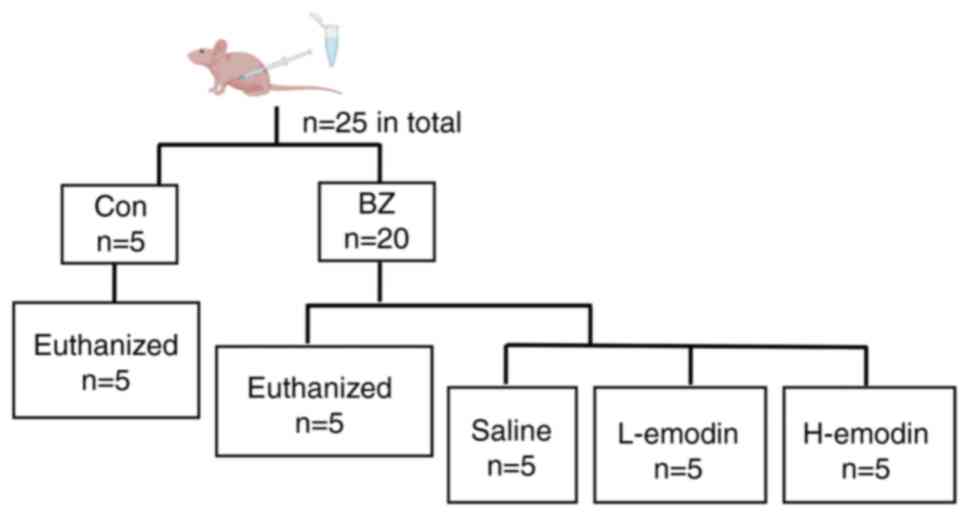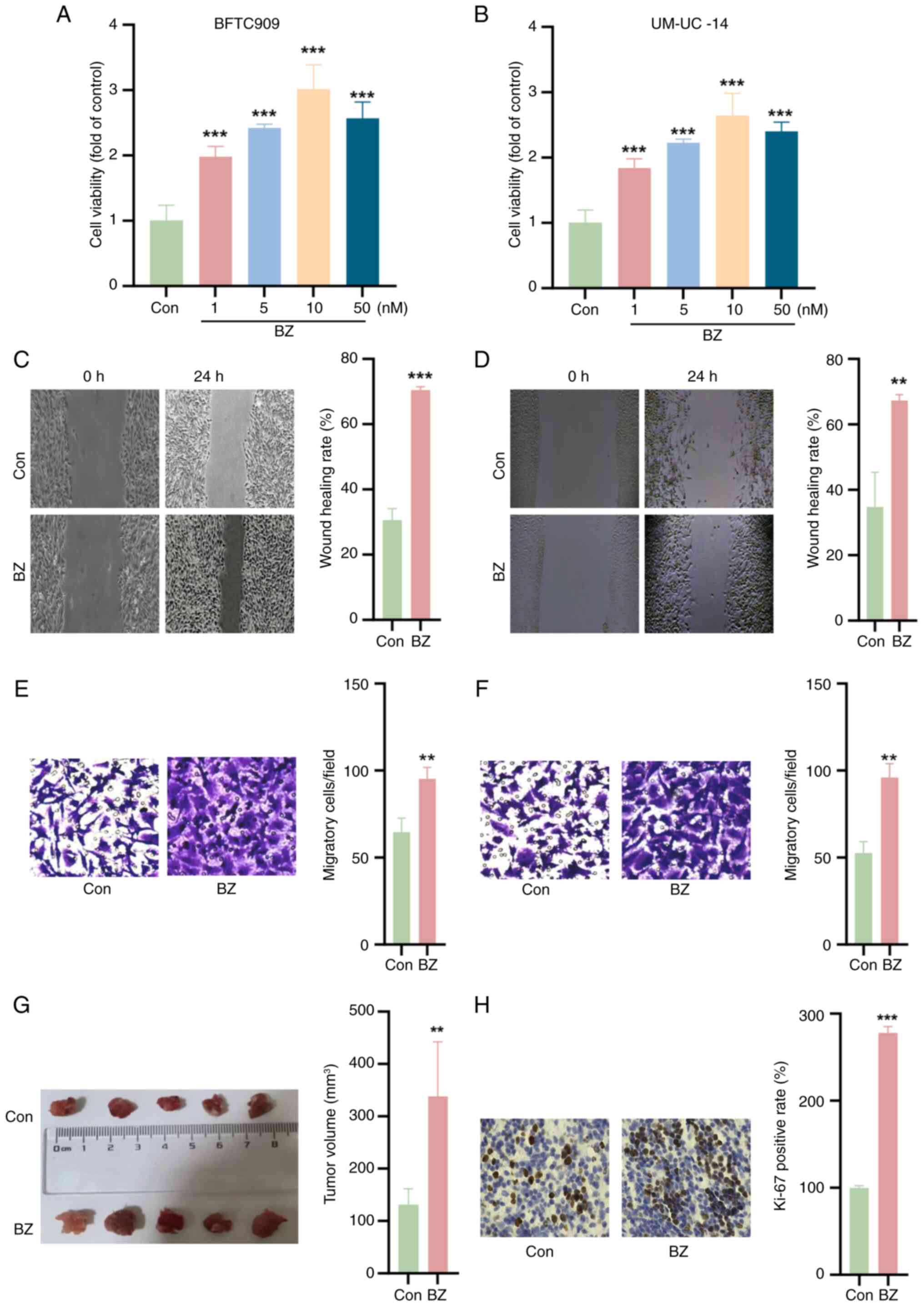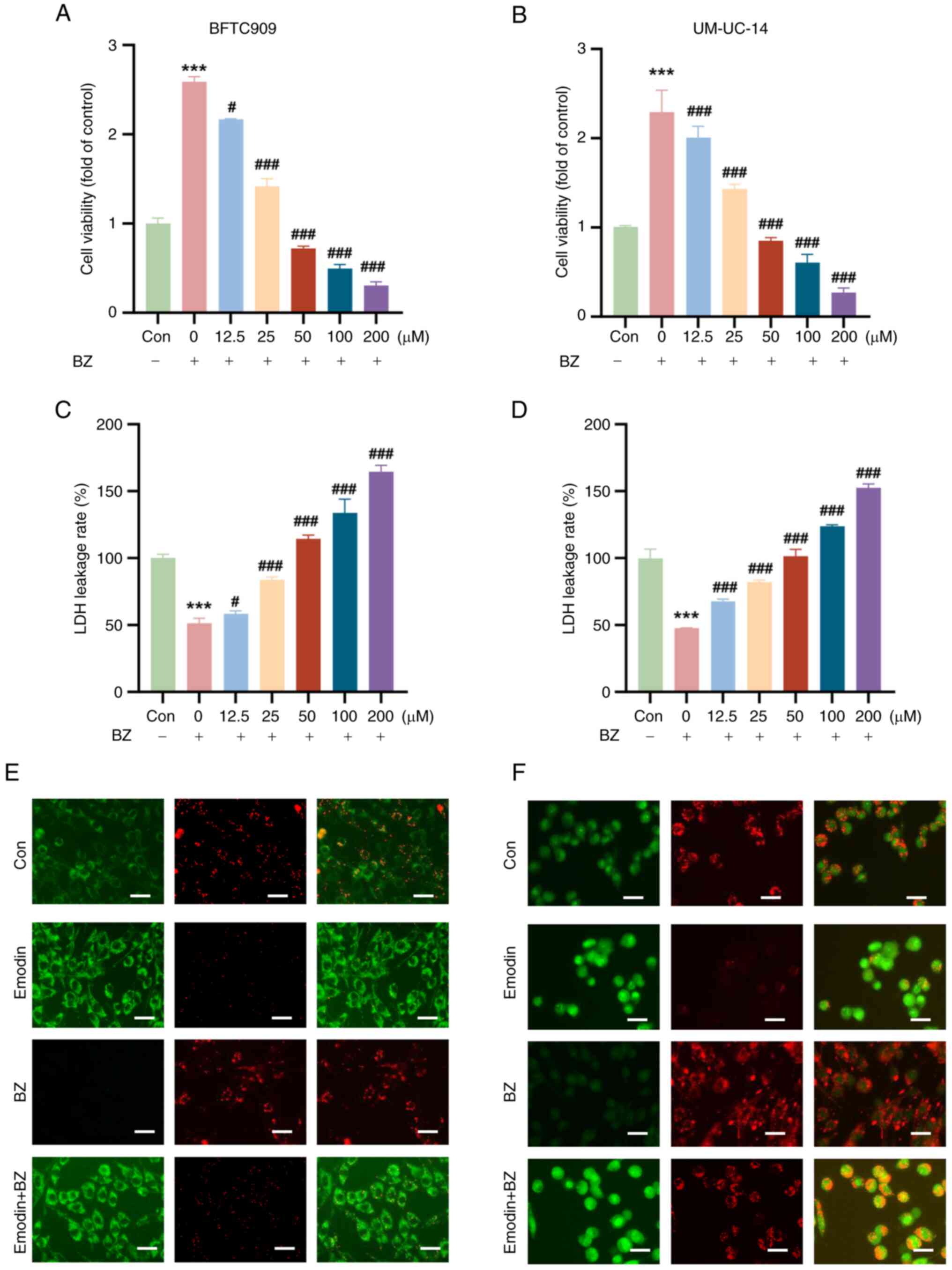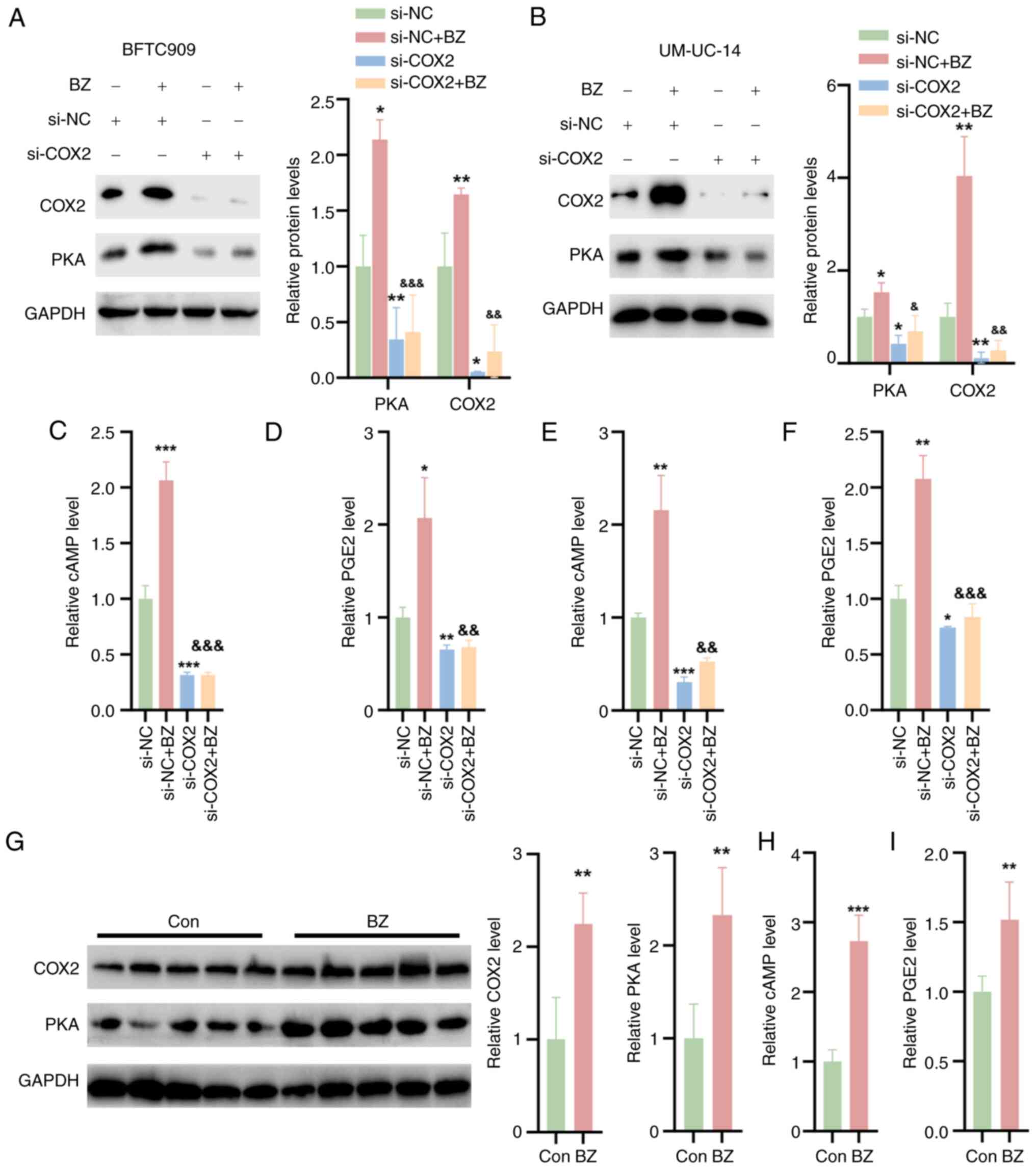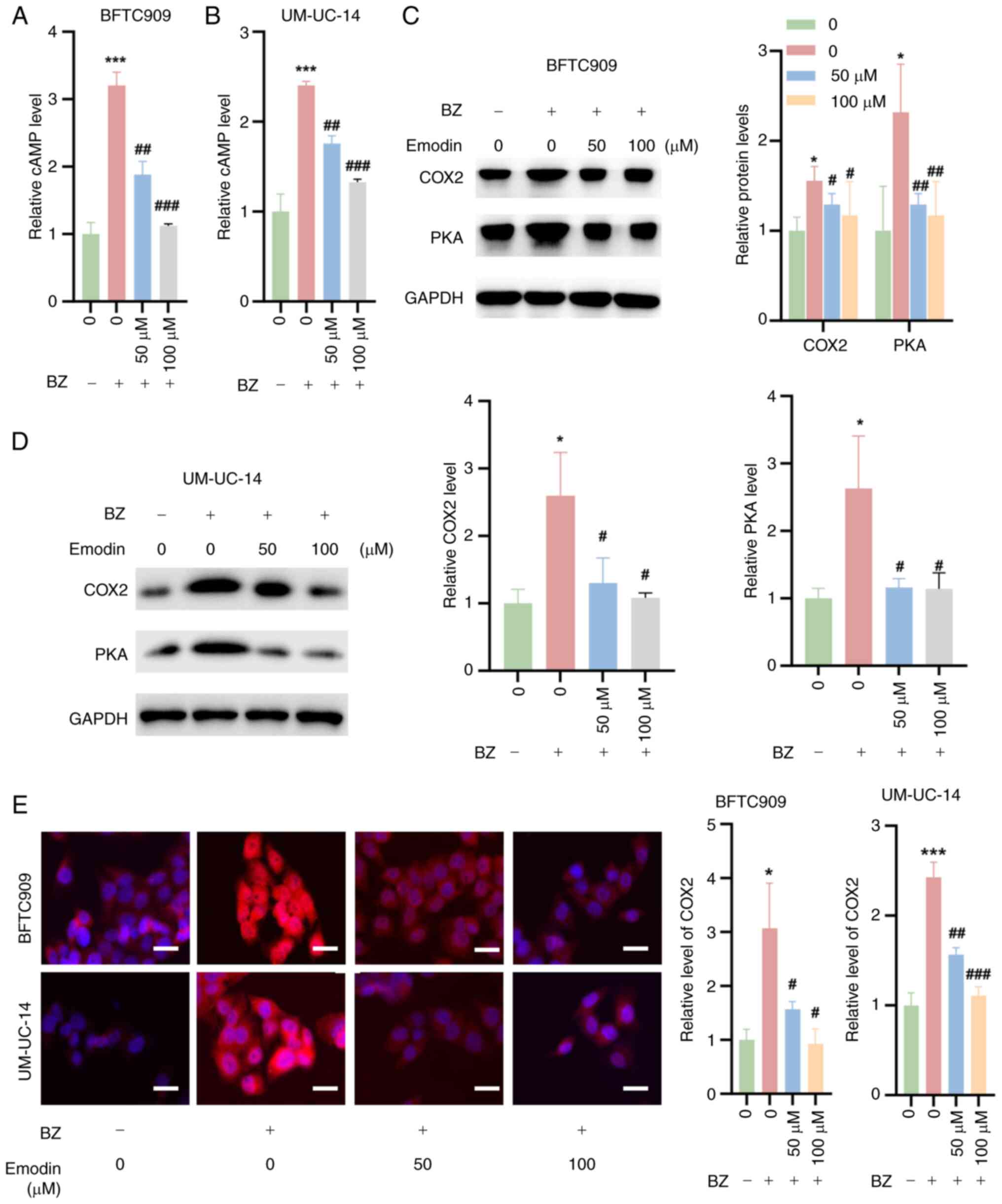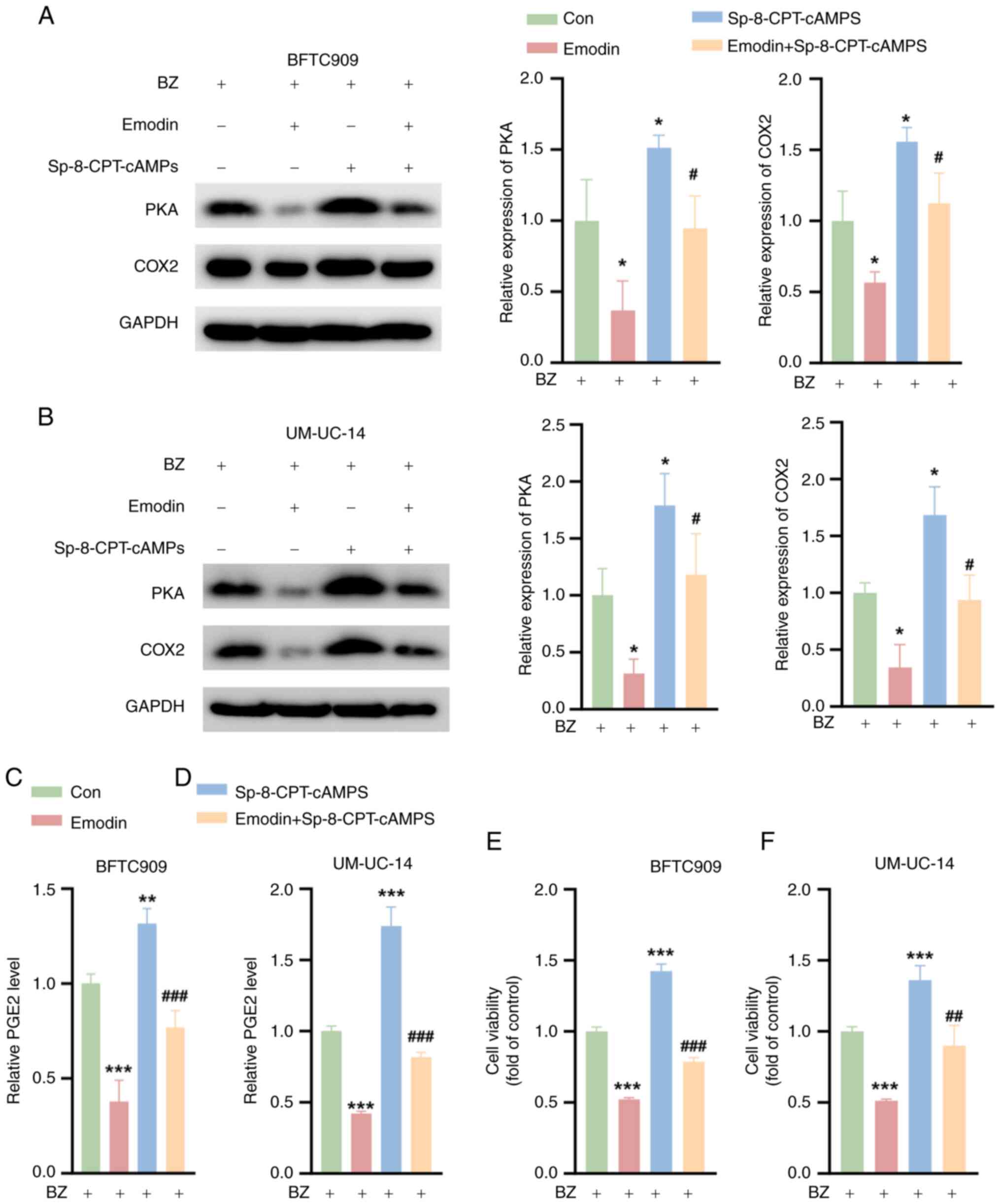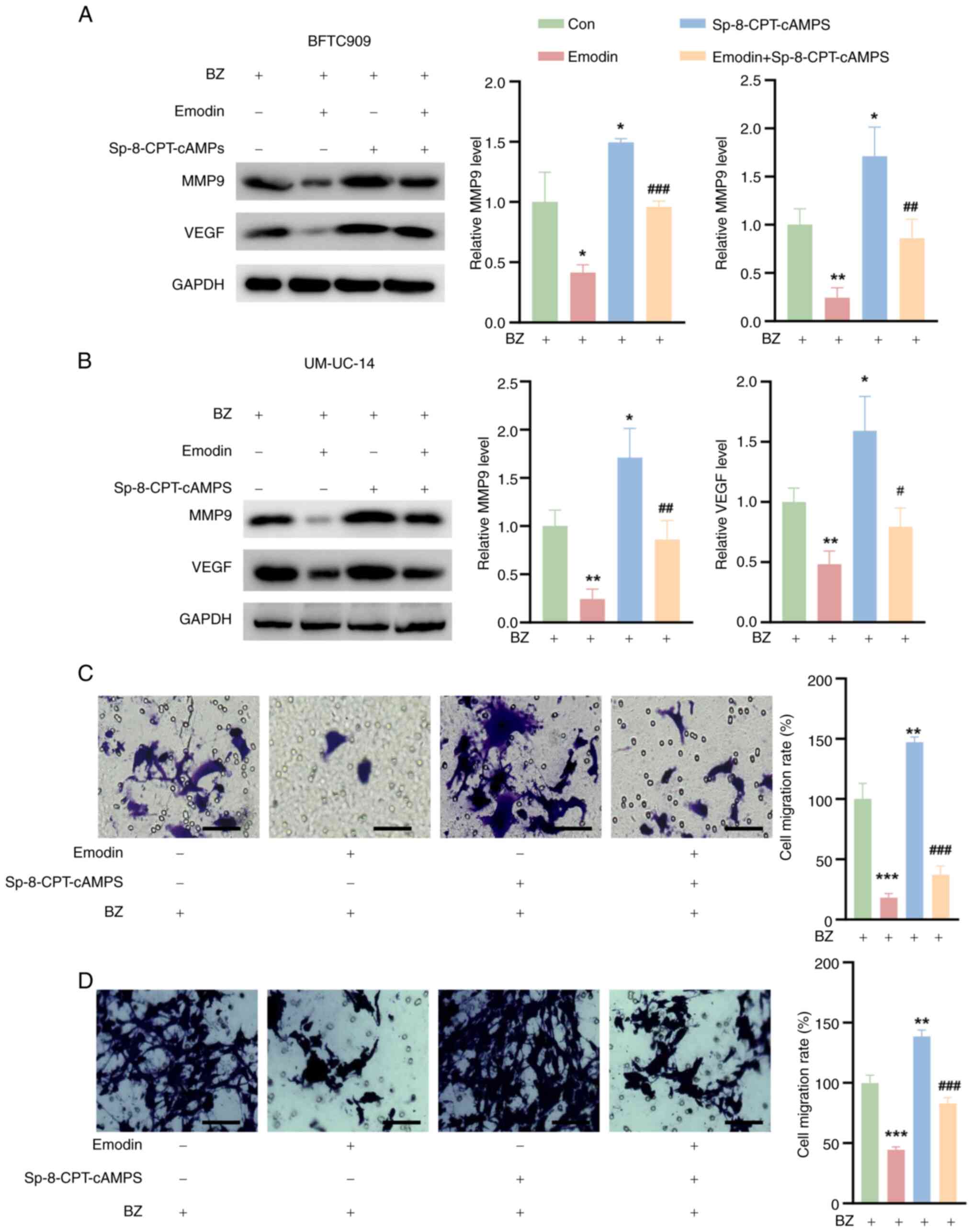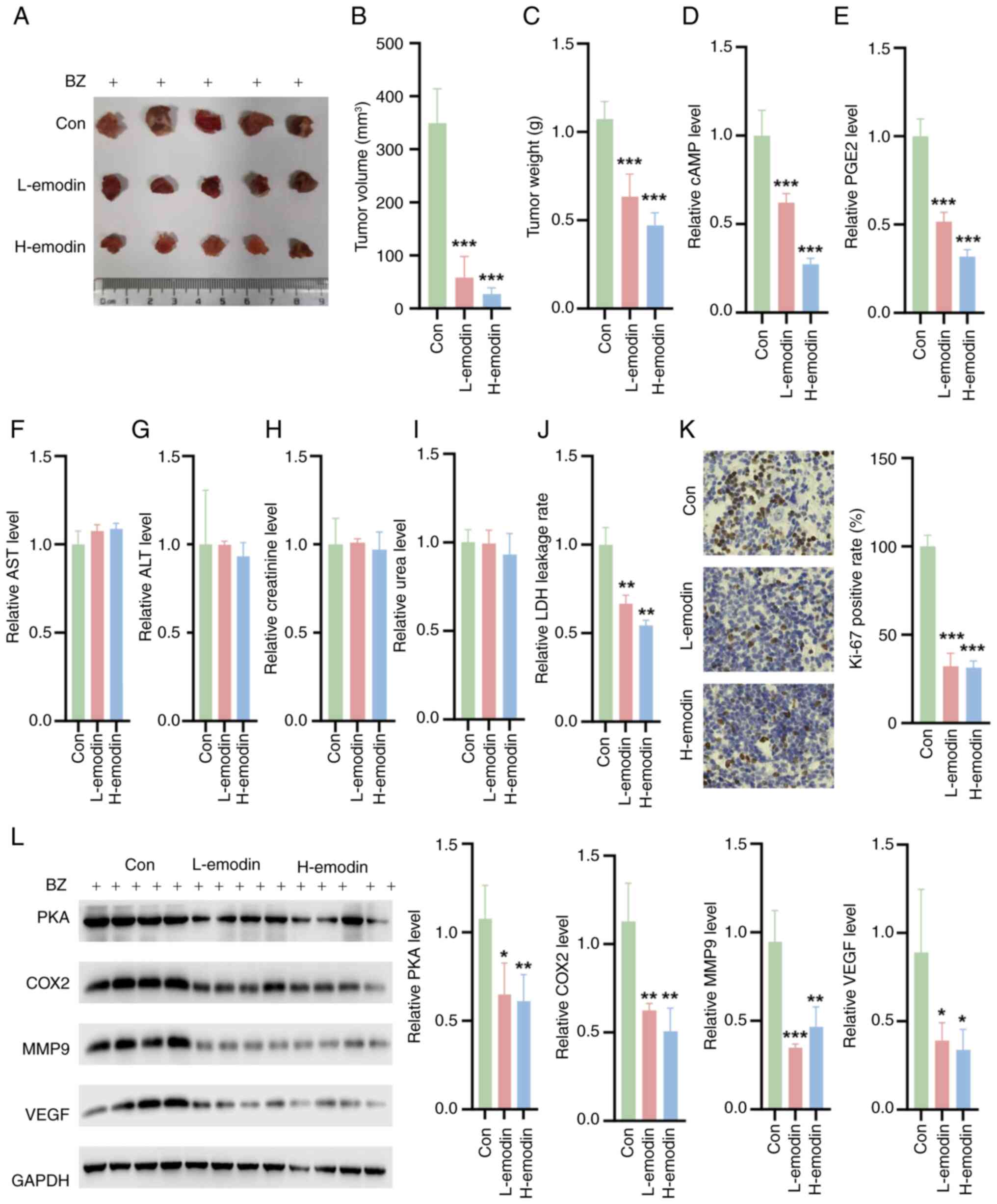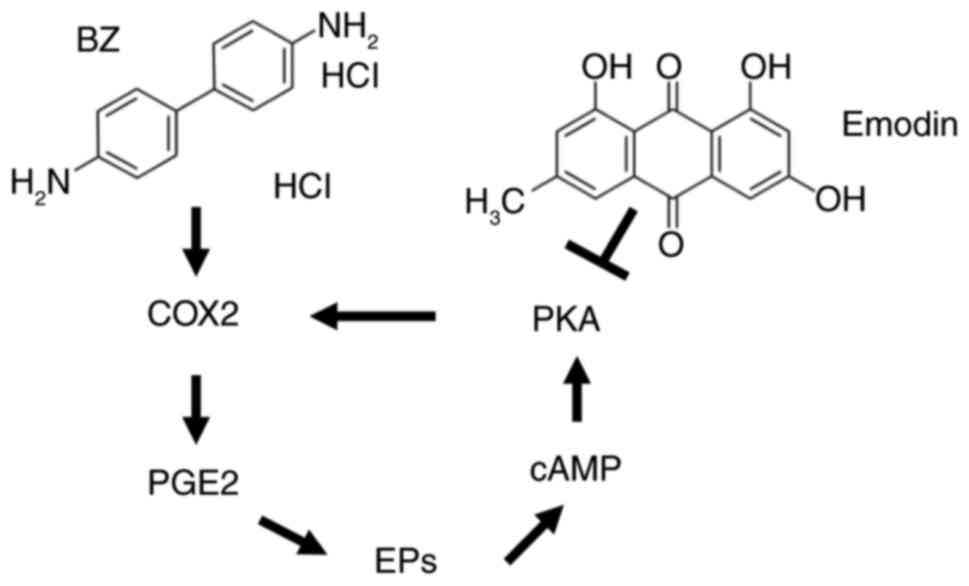Emodin inhibits benzidine‑enhanced survival and migration of upper urinary tract urothelial carcinoma cells by targeting the PKA/COX2 signaling pathway
- Authors:
- Published online on: September 12, 2024 https://doi.org/10.3892/ijo.2024.5691
- Article Number: 103
-
Copyright: © Jin et al. This is an open access article distributed under the terms of Creative Commons Attribution License.
Abstract
Introduction
Benzidine (BZ) is a chemical compound used in the production of dyes, and its sulfate is used predominantly in industry (1). However, its carcinogenic properties have been well established, particularly in relation to bladder cancer (2). Historical observations dating back to the late 19th century, such as Rehn's findings in German aniline dye factories, first highlighted the link between BZ exposure and bladder cancer (2). Subsequent epidemiological studies and experimental validation further confirmed the carcinogenic nature of BZ, leading to its classification as a human carcinogen by the International Agency for Research on Cancer in 1987 (3). Despite its ban in commercial production, BZ continues to pose health risks as it is still found in various products, including hair dyes, paints and plastics (4).
Given the well-documented association between BZ exposure and bladder cancer, concerns about its potential role in promoting other urothelial carcinoma types, such as upper urinary tract urothelial carcinoma (UTUC), have increased. While urothelial carcinoma of the bladder is the most common urinary tract malignancy, accounting for 95% of cases, UTUC accounts for the remaining 5% of cases (5). However, whether BZ exposure contributes to the development of UTUC remains largely unexplored. Investigating the potential link between BZ and UTUC could provide valuable insights into the broader impact of BZ exposure on urothelial carcinogenesis and inform preventive measures to mitigate its adverse health effects.
Prostaglandin E2 (PGE2), a metabolite of arachidonic acid catalyzed by cyclooxygenase 2 (COX2), is known to promote tumor cell proliferation, angiogenesis, invasion and metastasis (6). A previous study has established a close link between the occurrence and development of UC and PGE2 (7). PGE2 exerts its effects by binding to four types of prostaglandin E receptors on the cell membrane, which regulate intracellular cyclic adenosine monophosphate (cAMP) levels, calcium ion concentrations and phosphatidylinositol activation (7). Upon activation of these receptors, the G protein undergoes a conformational change, leading to the separation of the Gαs subunit from the Gβγ subunit, which subsequently activates adenylate cyclase to produce the second messenger cAMP (8). This molecule activates downstream regulatory elements such as protein kinase A (PKA), further promoting tumor proliferation and invasion (9). PKA expression may be linked to the invasive and metastatic properties of tumors, as its upregulation can activate metalloproteinases (MMPs), such as MMP9, which are essential for tumor infiltration (10). Additionally, PKA upregulation can increase the expression of several angiogenic factors, including vascular endothelial growth factor (VEGF) (11). In the context of UTUC, the COX2/PGE2/cAMP/PKA signaling pathway plays a critical role in tumor progression (12,13). Elevated levels of COX2 and its downstream products, such as PGE2, can enhance UTUC cell survival and migration. The subsequent increase in cAMP levels and activation of PKA further facilitates these processes, contributing to tumor growth and metastasis. Understanding the interplay between these molecular factors is crucial for developing targeted interventions to prevent or treat UTUC.
Rhubarb, a traditional Chinese herb, is renowned for its ability to enhance cardiovascular function (14,15). Emodin, a vital constituent present not only in rhubarb but also in various plants, such as Aloe vera, He Shou Wu and Tiger Balm (16), has garnered increasing attention for its notable antitumor, anti-inflammatory and antibacterial properties (14,15). Notably, a study has revealed that emodin suppresses VEGF transcription by targeting the transcription factors, nuclear receptor corepressor 2 and seryl-tRNA synthetase, thereby impeding triple-negative breast cancer progression (16). Furthermore, in colon cancer, emodin hinders angiogenesis by inhibiting the expression of acyl-CoA synthetase long-chain family member 4 (17).
Emodin has been shown to inhibit the development of bladder cancer (18,19). Hence, investigating whether emodin can counteract BZ-induced UTUC progression may provide valuable insights into mitigating the adverse health effects of BZ exposure and further understanding the broader impact of emodin on UC.
Materials and methods
Cell culture
BFTC909 cells were purchased from Shanghai Chuanqiu Biotechnology Co., Ltd. and incubated in DMEM/F12 (HyClone; Cytiva) supplemented with 10% fetal bovine serum (FBS; HyClone; Cytiva) at 37°C with 5% CO2. UM-UC-14 cells were purchased from Shanghai Fusheng Industrial Co., Ltd. and cultured in Eagle's minimum essential medium (Gibco; Thermo Fisher Scientific, Inc.) supplemented with 2 mM L-glutamine, 10% FBS, antibiotic-antimycotic and 1% non-essential amino acids at 37°C with 5% CO2.
Western blotting
The cells were incubated with high-efficiency RIPA lysis buffer (Beijing Solarbio Science & Technology Co., Ltd.) on ice for 5 min. After centrifugation at 11,000 × g for 20 min at 4°C, the supernatant was collected, and the protein concentration was determined using a BCA kit (Beijing Solarbio Science & Technology Co., Ltd.). Then, 20 μg/lane of sample was separated by 12.5% SDS-PAGE and transferred to a PVDF membrane, followed by incubation with 8% skim milk powder (Thermo Fisher Scientific, Inc.) at room temperature for 2 h. After washing with PBST (0.1% Tween) three times, the PVDF membrane was incubated with the following primary antibodies: Anti-PKA (cat. no. ab75991; 1:1,000), anti-COX2 (cat. no. ab179800; 1:1,000), anti-MMP9 (cat. no. ab76003; 1:1,000), anti-VEGF (cat. no. ab32152; 1:1,000) and anti-GAPDH (cat. no. ab8245; 1:3,000) (all primary antibodies were purchased from Abcam) at 4°C overnight. After three washes with PBST, the PVDF membranes were incubated with HRP-labeled secondary antibodies [1:5,000; cat. nos. SE131 (anti-mouse) and SE134 (anti-rabbit); Beijing Solarbio Science & Technology Co., Ltd.] at room temperature for 2 h. Subsequently, the protein expression signals were detected with ECL Western Blotting Substrate (Beijing Solarbio Science & Technology Co., Ltd.). GAPDH was used as an internal reference and ImageJ software (version 1.53a; National Institutes of Health; https://imagej.nih.gov/ij/) was used for analysis.
Cell Counting Kit-8 (CCK-8) assay
BFTC909 and UM-UC-14 cells were inoculated into 96-well cell culture plates at 1,000 cells per well and incubated at 37°C overnight. Subsequently, the cells were divided into the control, BZ (Sigma-Aldrich; Merck KGaA; 1, 5, 10 and 50 nM), and emodin (Sigma-Aldrich; Merck KGaA; 12.5, 25, 50, 100 and 200 μM) groups and incubated at 37°C for 48 h. Then, 10 μl CCK-8 solution (Beijing Solarbio Science & Technology Co., Ltd.) was added to each well and the cells were incubated at 37°C for 4 h. Finally, the absorbance was measured at 450 nm, and three replicate wells were set up for each group.
Determination of cAMP concentration and lactate dehydrogenase (LDH) leakage
BFTC909 and UM-UC-14 cells were lysed by sonication in an ice bath and centrifuged at 5,000 × g for 20 min at 4°C. After the supernatant was collected, the intracellular cAMP and LDH concentrations were analyzed using the cAMP Assay Kit (cat. no. ab65355; Abcam) and LDH Assay Kit (cat. no. ab102526; Abcam) according to the manufacturer's instructions.
Wound healing assay
BFTC909 and UM-UC-14 cells were inoculated at 5×105 cells/well in 6-well plates and incubated overnight. The next day, the cells were gently scraped with a 200 μl pipette tip, then washed well with PBS (this was noted as 0 h). Next, the BFTC909 and UM-UC-14 cells were treated with 10 nM BZ or 50 μM emodin at 37°C for 24 h in medium containing 2% serum. Representative images at 0 and 24 h were collected using a light microscope (Olympus Corporation), and the wound healing area was recorded (S1 represented the initial wound area, and S2 represented the wound area after 24 h of treatment). The cell migration rate (%) was calculated as [(S1-S2)/S1] ×100%, and each set of experiments was repeated three times. ImageJ software (version 1.53a; National Institutes of Health; https://imagej.nih.gov/ij/) was used for analysis.
Transwell assay
In brief, both BFTC909 and UM-UC-14 cells were seeded at a concentration of 1×104 in the upper chamber with 200 μl serum-free DMEM. Then, 600 μl DMEM containing 10% FBS was added to the lower chambers at 37°C for 24 h. Subsequently, the cells that migrated to the lower chamber were fixed with 4% paraformaldehyde (Beijing Solarbio Science & Technology Co., Ltd.) at room temperature for 20 min and stained with 0.1% crystal violet for 20 min at room temperature. Representative images were observed under a light microscope (Olympus Corporation). ImageJ software (version 1.53a; National Institutes of Health; https://imagej.nih.gov/ij/) was used for analysis.
Small interfering RNA (siRNA) transfection
BFTC909 and UM-UC-14 cells were inoculated at a density of 5×105 cells/well in 6-well plates and incubated overnight. Next, 10 μl siRNA targeting COX2 (sense, 5′-AAAUUUGAACAAUAAUUUGGU-3′; antisense, 5′-CAAAUUAUUGUUCAAAUUUAG-3′) or negative control (NC; sense, 5′-UUCUCCGAACGUGUCACGUTT-3′; antisense, 5′-ACGUGACACGUUCGGAGAATT-3′) (Shanghai GenePharma Co., Ltd.) was added to serum-free medium to achieve a final concentration of 20 nM. Then, 10 μl HiPerFect Transfection Reagent (Qiagen GmbH) was added to the siRNA solution. The mixture was incubated at room temperature for 15 min to form siRNA-HiPerFect complexes. The complexes were carefully added to the respective wells and incubated at 37°C in a 5% CO2 incubator for 24 h. After the incubation period, the cells were collected for subsequent experiments.
Sp-8-CPT-cAMPS treatment
The cells were divided into four groups for treatment: i) Control (Con) group, cells were treated with 10 nM BZ alone for 48 h; ii) emodin group, cells were pretreated with 50 μM emodin for 1 h, followed by the addition of 10 nM BZ for 48 h; iii) Sp-8-CPT-cAMPS group, cells were pretreated with 10 μM Sp-8-CPT-cAMPS (cat. no. HY-120994B; MedChemExpress) for 1 h, followed by the addition of 10 nM BZ for 48 h; and iv) emodin + Sp-8-CPT-cAMPS group, cells were pretreated with a combination of 10 μM Sp-8-CPT-cAMPS and 50 μM emodin for 1 h, followed by the addition of 10 nM BZ for 48 h. Then, the cells were collected for further assay.
Detection of intracellular malondialdehyde (MDA), superoxide dismutase (SOD), reactive oxygen species (ROS) and total antioxidant capacity
Intracellular MDA, SOD, ROS and total antioxidant capacity were analyzed using a Lipid Peroxidation MDA Assay Kit (cat. no. S0131M; Beyotime Institute of Biotechnology), Reactive Oxygen Species Assay Kit (cat. no. S0033S; Beyotime Institute of Biotechnology), Total Superoxide Dismutase Assay Kit (cat. no. S0101S; Beyotime Institute of Biotechnology) and Total Antioxidant Capacity Assay Kit (cat. no. S0121; Beyotime Institute of Biotechnology), respectively. All operations were carried out in strict accordance with the instruction manuals.
Intracellular Ca2+ assay
Detection of intracellular calcium ion levels was accomplished using an Intracellular Ca2+ Calcium Ion Assay Kit (cat. no. HR8227; Beijing Biolab Technology Co., Ltd.). Briefly, BFTC909 and UM-UC-14 cells were collected, and F04 staining solution was incubated with the cells at 37°C for 30 min, after which the intracellular Ca2+ content was detected (excitation wavelength of 488-495 nm and emission wavelength of 516 nm).
JC-1 staining
The cells were initially divided into four groups: The control, emodin (50 μM), BZ (10 nM) and BZ + emodin groups. BFTC909 and UM-UC-14 cells were then treated with the indicated drugs for 24 h. Subsequently, the cells were co-incubated with a final concentration of 1 μM JC-1 dye at 37°C for 30 min. After staining, the cells were washed with PBS and observed under a fluorescence microscope (Olympus Corporation) to assess changes in the mitochondrial membrane potential. At low membrane potentials, JC-1 emits green fluorescence as a monomer, whereas at higher potentials, JC-1 forms 'J-aggregates', emitting red fluorescence.
Nude mouse tumor assay
SPF male BALB/c-nu nude mice (6-8 weeks old; n=25) weighing 15-20 g were obtained from Jinzhou Medical University Experimental Animal Center (Jinzhou, China). All mice were kept in housing with free access to food and water, in an environment with a temperature of 20-24°C and a humidity level of 45-55% throughout a 12 h light/dark cycle. In the experiment, a BFTC909 cell suspension was prepared at a density of 5×107 cells/ml, 0.1 ml was then subcutaneously inoculated into the dorsal region of the nude mice to construct UTUC transplantation tumors. The tumor formation time was 14 days. Subsequently, the nude mice were divided into two groups: The control (n=5) and BZ (n=20) groups (Fig. 1). In the BZ group, nude mice were administered BZ at a dose of 22 mg/kg body weight in 1 ml of water per dose via gavage for 5 consecutive days, based on previous studies (20,21). The control group was administered an equal volume of water. Subsequently, nude mice in the control and BZ groups (n=5 for each group) were sacrificed, and the tumor volume was evaluated as follows: tumor volume=length × width2/2. After evaluation, the remaining 15 nude mice in the BZ group were randomly divided into three groups: the Control (Con) vehicle group, the Low-dose emodin (L-emodin) group, and the High-dose emodin (H-emodin) group. The Control vehicle group received 1 ml of 2% DMSO in saline by gavage once daily. The L-emodin group was administered emodin at a dose of 40 mg/kg intraperitoneally in 1 ml of PBS once daily, while the H-emodin group received emodin at a dose of 80 mg/kg intraperitoneally in 1 ml of PBS once daily. The entire intervention process lasted for 4 weeks.
The humane endpoints used to determine when animals should be euthanized were severe behavioral abnormalities, such as persistent self-mutilation or inability to move normally. The entire intervention process lasted for 4 weeks, and the tumor formation time was 14 days. Thus, the total duration of the experiment was 6 weeks. No animals were euthanized before the end of the study. There were also no instances of animal death due to the experimental procedures. Animal health and behavior were monitored once daily. For anesthesia, the mice were anesthetized using isoflurane, with an induction concentration of 2-3% and a maintenance concentration of 1.5-2%. Deep anesthesia was confirmed by the absence of a response to a paw pinch and the absence of a corneal reflex, following ethical guidelines for animal experimentation. Once deep anesthesia was achieved, ~0.6 ml of cardiac blood was collected via cardiac puncture. Death was verified by confirming the absence of a response to a paw pinch and the absence of a corneal reflex. After blood collection, the subcutaneous xenograft tumors were harvested for further experiments, including the determination of cAMP and PGE2 levels, western blotting and immunohistochemistry (IHC).
Detection of alanine aminotransferase (ALT), aspartate aminotransferase (AST), creatinine and urea levels
The blood samples were centrifuged at 1,500 × g for 10 min at 4°C to separate the serum. An automated biochemical analyzer (Hitachi High-Technologies, Japan) was used to measure the ALT, AST, creatinine and urea levels in the serum, using the respective detection kits: ALT Detection Kit, AST Detection Kit, Creatinine Detection Kit and Urea Detection Kit (all from Zybio Inc.).
IHC
Tumor tissues were fixed using 4% paraformaldehyde (Beijing Solarbio Science & Technology Co., Ltd.) for 24 h at room temperature. After fixation, the tissues were dehydrated with gradient alcohol, cleared with xylene and finally embedded in paraffin. Specifically, the embedded tissues were cut into 5 μm-thick sections, sequentially placed in xylene (three times, 10 min each), gradient alcohol (100, 95, 85 and 70%, 5 min each), and finally washed with distilled water. The tissue sections were autoclave-treated in sodium citrate buffer (pH 6.0; Beijing Solarbio Science & Technology Co., Ltd.) for 15 min. After deparaffinization and rehydration, sections were incubated with 3% hydrogen peroxide (cat. no. H1009; MilliporeSigma) in methanol for 10 min at room temperature to quench endogenous peroxidase activity. Afterwards, the sections were blocked with a solution containing 5% BSA (Thermo Fisher Scientific, Inc.) for 30 min at room temperature. A Ki-67 (1:50; cat. no. 9449, CST Biological Reagents Co., Ltd.) primary antibody was added dropwise to the tissue sections and incubated overnight at 4°C in a wet box. The sections were subsequently washed three times with PBS for 5 min each. Biotinylated secondary antibodies (1:50; cat. no. SHB131; Beijing Solarbio Science & Technology Co., Ltd.) were added to the sections and incubated for 60 min at room temperature. The sections were washed three times with PBS for 5 min each. DAB color development solution (OriGene Technologies, Inc.) was added dropwise to the sections and incubated for 3 min at room temperature, then the reaction was terminated with distilled water. The nuclei were lightly stained with hematoxylin (Beijing Solarbio Science & Technology Co., Ltd.) for 30 sec at room temperature and washed with tap water. Subsequently, the sections were dehydrated with gradient alcohol, cleared with xylene, and blocked with neutral gum (Beijing Solarbio Science & Technology Co., Ltd.). The sections were finally visualized with a light microscope (BZ-X; Keyence Corporation). ImageJ software (version 1.53a; National Institutes of Health; https://imagej.nih.gov/ij/) was used for analysis. The Ki-67 positive cell rate=(Ki-67 positive cells/total cells) ×100%.
Immunofluorescence (IF)
The cells were fixed in 4% paraformaldehyde for 15 min at room temperature. The cells were subsequently washed three times with PBS for 5 min each, then permeabilized with 0.3% Triton X-100 (in PBS) for 10 min at room temperature. The cells were blocked with 5% BSA (Thermo Fisher Scientific, Inc.) for 1 h at room temperature, followed by overnight incubation with a COX2 primary antibody (1:50; cat. no. ab179800; Abcam) in a wet box at 4°C. The cells were subsequently washed three times with PBS for 5 min each. The cells were incubated with goat anti-rabbit IgG/Cy3 (1:200; cat. no. K1034G-Cy3; Beijing Solarbio Science & Technology Co., Ltd.) in a wet box protected from the light for 1 h at room temperature. The cells were incubated with Hoechst (Beijing Solarbio Science & Technology Co., Ltd.) for 10 min at room temperature, then washed three times with PBS for 5 min each time. The coverslips were sealed with a sealer containing an anti-fluorescence attenuation reagent (Beijing Solarbio Science & Technology Co., Ltd.). The cells were observed using a fluorescence microscope (Keyence Corporation).
Statistical analysis
The data are presented as the mean ± standard deviation and were analyzed using Prism 9.0 (Dotmatics). Comparisons between two groups were made using unpaired Student's t-test, and comparisons between more than two groups were made using one-way ANOVA followed by Tukey's HSD test. P<0.05 was considered to indicate statistically significant difference.
Results
BZ promotes UTUC tumor growth
The impact of BZ on the viability of BFTC and UM-UC-14 cells was initially investigated. As shown in Fig. 2A and B, BZ significantly enhanced the viability of both cell lines at concentrations of 1, 5, 10 and 50 nM. Furthermore, the wound healing and Transwell assays demonstrated that BZ facilitated the migration of BFTC and UM-UC-14 cells (Fig. 2C-F). Subsequent in vivo experiments further validated these findings, indicating that BZ promoted subcutaneous tumor growth in nude mice (Fig. 2G). IHC staining revealed that BZ increased the percentage of Ki-67-positive cells compared with the control group (Fig. 2H).
Emodin decreases cell viability and mitochondrial membrane potential in BZ-Induced malignant cells
It was next evaluated whether emodin could inhibit BZ-induced malignant cell survival in vitro. Compared with BZ alone (10 nM), emodin significantly reduced the viability of both BFTC and UM-UC-14 cells (at concentrations of 12.5, 25, 50, 100, and 200 μM) in a concentration-dependent manner (Fig. 3A and B). The LDH leakage rate, a critical indicator of cell damage, was significantly lower in the BZ-treated group than in the control group; however, emodin treatment increased the LDH leakage rate (Fig. 3C and D). Changes in mitochondrial membrane potential were assessed using the JC-1 staining method. JC-1 is a commonly used fluorescent probe for evaluating mitochondrial membrane potential; it forms aggregates and emits red fluorescence at high membrane potential, while at low membrane potential, it remains in the monomeric form and emits green fluorescence. In this experiment, strong red fluorescence was observed in the untreated control group, indicating a high mitochondrial membrane potential. Compared with the control, cells treated with emodin showed a significant decrease in red fluorescence and an increase in green fluorescence in both BFTC and UM-UC-14 cells, indicating a decrease in mitochondrial membrane potential. Even in the presence of BZ, emodin effectively lowered the mitochondrial membrane potential, as evidenced by the reduced red and increased green fluorescence (Fig. 3E and F).
BZ activates COX2/PKA signaling in UTUC
The effect of BZ on the COX2/PKA signaling pathway was further investigated. It was observed that BZ significantly upregulated the protein expression of PKA and COX2 in BFTC and UM-UC-14 cells transfected with si-NC (Fig. 4A and B). To investigate the role of COX2 in BZ-induced PKA signaling activation, siRNAs specifically targeting COX2 were screened. si-COX2 effectively downregulated COX2 expression and subsequently reduced PKA expression. Furthermore, COX2 knockdown reversed the BZ-induced increase in PKA expression. These findings indicated that BZ-mediated activation of PKA signaling was achieved through the induction of COX2 (Fig. 4A and 4B). Additionally, BZ treatment led to increased levels of cAMP and PGE2 in cell lysates, but si-COX2 reversed these effects with or without BZ treatment (Fig. 4C-F). In vivo, BZ also elevated the protein expression of PKA and COX2 in tumor tissues from nude mice (Fig. 4G) and increased the levels of cAMP and PGE2 within these tumors (Fig. 4H and I).
Emodin inhibits cAMP/PKA/COX2 signaling in UTUC cells in the presence of BZ
It was also investigated whether emodin inhibits the cAMP/PKA/COX2 signaling pathway in UTUC cells in the presence of BZ. The findings indicated that emodin combined with BZ markedly decreased cAMP levels in BFTC909 and UM-UC-14 cells compared with BZ treatment alone (Fig. 5A and B). Additionally, western blotting analysis revealed that emodin significantly suppressed the expression of PKA and the downstream effector COX2 in these cells at concentrations of 25 and 50 μM, compared with BZ treatment alone (Fig. 5C and D). Additionally, IF experiments confirmed that BZ increased COX2 expression in BFTC909 and UM-UC-14 cells, while emodin treatment reduced the BZ-induced increase in COX2 expression (Fig. 5E).
Emodin inhibits the survival of UTUC cells by inhibiting PKA signaling when combined with BZ
To further investigate the capacity of emodin to suppress the malignant phenotype of UTUC cells by inhibiting PKA signaling, the BFTC909 and UM-UC-14 cells were preincubated with BZ before further treatment. Subsequent exposure to Sp-8-CPT-cAMPS, a PKA activator, resulted in a significant increase in PKA and COX2 protein levels, as demonstrated by western blotting analysis (Fig. 6A and B). Notably, the emodin-induced downregulation of PKA and COX2 expression was partially reversed by Sp-8-CPT-cAMPS. Additionally, while emodin significantly reduced the PGE2 levels, treatment with Sp-8-CPT-cAMPS led to an increase in PGE2 production and it significantly reversed the reduction caused by emodin (Fig. 6C and D). In terms of cell viability, compared with the control, Sp-8-CPT-cAMPS notably enhanced the survival of BFTC909 and UM-UC-14 cells, and it notably mitigated the emodin-induced decrease in cell viability (Fig. 6E and F). These findings suggest that emodin effectively inhibits the viability of UTUC cells predominantly through the inhibition of PKA signaling.
Emodin reduces UTUC cell migration by inhibiting MMP9 and VEGF
Previous studies have shown that PGE2 enhances tumor cell infiltration and metastasis by upregulating MMP9 and VEGF (22,23). In the present study, the effects of emodin on the expression of these critical proteins was investigated. The BFTC909 and UM-UC-14 cells were preincubated with 10 nM BZ before further treatment. It was observed that emodin significantly reduced the expression of MMP9 and VEGF in both BZ-treated BFTC909 and UM-UC-14 cells compared with the control cells. Conversely, treatment with Sp-8-CPT-cAMPS alone led to an increase in the expression of these proteins (Fig. 7A and B). Notably, Sp-8-CPT-cAMPS also counteracted the suppressive effect of emodin on MMP9 and VEGF expression (Fig. 7A and B). Furthermore, emodin decreased the migration of BFTC909 and UM-UC-14 cells relative to that of control cells, while Sp-8-CPT-cAMPS promoted cell migration (Fig. 7C and D). Most notably, Sp-8-CPT-cAMPS reversed the emodin-induced decrease in migration in these BZ-treated cell lines (Fig. 7C and D).
Emodin inhibits tumor growth in nude mice in vivo
In vivo experiments involving nude mice pretreated with BZ confirmed that emodin could effectively decrease the weight and volume of tumors (Fig. 8A-C). Additionally, emodin reduced the levels of cAMP and PGE2 in tumor tissues (Fig. 8D and E). The in vivo safety of emodin was also evaluated. The experimental results showed that emodin did not have any significant toxic effects on the liver or kidneys of the treated mice. Liver function tests, including the measurement of ALT and AST enzymes, revealed no significant differences between the emodin-treated group and the control group (Fig. 8F and G). Similarly, kidney function markers, such as creatinine and UREA, remained within the normal ranges, indicating no renal toxicity (Fig. 8H and I). By contrast, emodin decreased the LDH leakage rate in tumor tissues compared with the control tissues (Fig. 8J). Ki-67 staining also showed that L-emodin and H-emodin decreased the percentage of Ki-67-positive cells (Fig. 8K). Furthermore, there was a notable decrease in the expression of MMP9 and VEGF in the tumor tissues of these nude mice (Fig. 8L). These findings collectively indicate that emodin exerts a notable inhibitory effect on tumor development in vivo.
Discussion
Bladder cancer ranks as the most prevalent and lethal among common malignant tumors of the urinary system. The primary environmental contributors to bladder cancer include tobacco smoke, arsenic in drinking water and occupational exposure to aromatic amines (24,25). BZ, known for its carcinogenic properties, has been banned in industrial production (26). Nevertheless, it is still detected in certain food colors. Moreover, with the increase in tobacco use, BZ continues to significantly contribute to the incidence of bladder tumors (26). UTUC, involving tumors of the renal pelvis and ureters, demands careful clinical attention due to its recurring and highly malignant nature (27). Early detection and appropriate treatment can lead to clinical remission (27). A number of patients with UTUC, particularly older adults, are asymptomatic and are often diagnosed during routine health examinations (28). Notably, the incidence of UTUC is markedly greater among smokers than non-smokers and poses a greater risk to individuals working in petrochemical, plastics and other chemical industries (28). Research on the mechanisms of BZ-induced UTUC is still limited. To the best of our knowledge, the present study is the first to provide in vitro evidence that BZ promotes the survival and migration of UTUC cells, thus supporting tumor growth. These findings establish the significant carcinogenic role of BZ in the progression of UTUC.
Natural drugs are increasingly recognized as vital sources for developing therapeutic agents due to their broad biological impacts and minimal side effects (16). Among these, Rheum officinale, particularly its anthraquinone derivatives extracted from its roots and rhizomes, has shown promising potential due to its anti-inflammatory, antifibrotic, antioxidant, antitumor and antidiabetic properties (29). Despite these known effects, the protective role of emodin, a compound derived from R. officinale, against BZ-induced UTUC remains unexplored. The results of the in vitro experiments in the present study revealed that emodin can significantly mitigate the BZ-induced increase in UTUC cell viability and decrease the LDH leakage rate. Additionally, emodin attenuated the increase in the mitochondrial membrane potential induced by BZ. These findings preliminarily indicate that emodin may have a crucial protective role in the progression of BZ-induced UTUC, highlighting its potential as a therapeutic agent in oncological treatments.
PGE2, the most prevalent arachidonoid lipid and a lipid metabolite with immunomodulatory functions, has been implicated in the development of various malignant tumors, such as pancreatic cancer, bladder cancer and UTUC (13,30,31). Previous studies have demonstrated that emodin inhibits PGE2 production (32,33). Therefore, the present investigation aimed to evaluate whether BZ activates PGE2-associated signaling pathways to facilitate the viability of UTUC cells. Both the in vitro and in vivo experiments confirmed that BZ upregulated the expression of PKA and COX2, concomitantly increasing the cAMP and PGE2 levels. The present investigation further revealed that BZ significantly upregulated the expression of VEGF and MMP9, which are pivotal factors implicated in tumor angiogenesis and invasion. These findings not only elucidated the role of BZ in promoting the progression of UTUC but also shed light on its potential carcinogenic effects on the upper urinary tract system, extending beyond its association with bladder cancer. In the EP2-cAMP-PKA signaling pathway, there is a positive feedback loop that regulates the expression of PGE2 and COX2 (34-36). Specifically, activation of PKA leads to an increase in COX2 expression (37-40). This occurs since PKA can phosphorylate and activate transcription factors that upregulate the expression of COX2. Consequently, when a PKA activator is introduced, it enhances PKA activity, which in turn elevates COX2 levels (38-40). Similarly, PGE2 and cAMP are involved in a positive feedback mechanism. PGE2 can increase cAMP levels by binding to its receptor, EP2, which activates adenylate cyclase. This enzyme catalyzes the conversion of ATP to cAMP (38-40). Elevated cAMP levels then activate PKA, which further increases COX2 expression and subsequently PGE2 production. Hence, in the present study, BFTC909 and UM-UC-14 cells, which were pretreated with BZ, were treated with a PKA activator, Sp-8-CPT-cAMPS, to test whether emodin exerts an anti-UTUC effect by targeting the PKA/COX2 signaling pathway. Compared with the control group, emodin treatment resulted in a notable reduction in the expression levels of PKA, COX2, VEGF and MMP9. Furthermore, the emodin-induced decreases in PKA, COX2, VEGF and MMP9 expression were significantly reversed upon the addition of Sp-8-CPT-cAMPS. Based on these extensive research findings, we consider that the current data sufficiently demonstrate the feedback regulation of COX2 by PKA. However, we recognize the importance of directly demonstrating the role of PKA. To address this, we plan to conduct further experiments to directly downregulate PKA using siRNA or pharmacological inhibitors to assess its impact on COX2 expression and the overall signaling pathway.
Moreover, in the present study, in the in vivo experiments using nude mice with BZ-induced subcutaneous tumors, emodin administration led to a reduction in tumor volume. Additionally, emodin treatment decreased PGE2 and cAMP levels and reduced MMP9 and VEGF expression. These novel findings highlight the crucial role of emodin in abolishing BZ-associated UTUC development by targeting the PKA/COX2 signaling pathway, indicating that emodin is a promising therapeutic strategy for occupational UTUC treatment. Additionally, the experimental results showed that emodin did not have any significant toxic effects on the liver or kidneys of the treated mice. Liver function tests, including measurements of ALT and AST levels, revealed no significant differences between the emodin-treated group and the control group. Similarly, kidney function markers, such as creatinine and UREA, remained within normal ranges, indicating no renal toxicity. These findings were consistent with previous studies that demonstrated the safety profile of emodin in similar settings (16,19). The lack of hepatotoxicity and nephrotoxicity is particularly notable given the prolonged treatment duration and the relatively high doses used in the experiments of the present study. This finding confirmed that the observed therapeutic effects of emodin on inhibiting BZ-induced cell survival and migration are not confounded by potential organ toxicity. Future studies should continue to monitor these safety parameters in different models and at different doses to further confirm the non-toxic nature of emodin, thereby supporting its potential clinical application in treating UTUC.
In conclusion, emodin inhibits the activity of the PKA/COX2 signaling pathway, thereby suppressing the development of UTUC induced by BZ exposure (Fig. 9). These findings lay the groundwork for a comprehensive understanding of the molecular mechanisms underlying BZ-induced UTUC, highlighting the potential of PKA/COX2 pathway inhibitors as crucial targets for early intervention in UTUC. Hence, emodin has emerged as a promising candidate for both early intervention and therapeutic strategies in UTUC management.
Availability of data and materials
The data generated in the present study may be requested from the corresponding author.
Authors' contributions
YJ performed the experiments and analyzed the data. CW, KF, XW and MT performed the animal experiments. YJ and GT designed all the experiments, analyzed the data and gave final approval for the version to be published. YJ and GT confirm the authenticity of all the raw data. All the authors have read and approved the final version of the manuscript.
Ethics approval and consent to participate
This study involving animals was reviewed and approved by Jinzhou Medical University (Jinzhou, China; approval no. 2020-AJ-05).
Patient consent for publication
Not applicable.
Competing interests
The authors declare that they have no competing interests.
Acknowledgements
Not applicable.
Funding
This study was supported by the Scientific Research Funding Project of Liaoning Provincial Department of Education (grant no. JYTJCZR2020063).
References
|
Habil MR and Hein DW: Effects of dose and human N-acetyltransferase 1 genetic polymorphism in benzidine metabolism and genotoxicity. Arch Toxicol. 97:1765–1772. 2023. View Article : Google Scholar : PubMed/NCBI | |
|
Dietrich HG and Golka K: Bladder tumors and aromatic amines-historical milestones from Ludwig Rehn to Wilhelm Hueper. Front Biosci (Elite Ed). 4:279–288. 2012. View Article : Google Scholar | |
|
Durgaryan R and Durgaryan N: Chemical oxidative condensation of benzidine in non-aqueous medium: Synthesis and investigation of oligomers and polymer with Benzidine Diimine Units. Polymers (Basel). 14:342021. View Article : Google Scholar | |
|
Suarez-Torres JD, Orozco CA and Ciangherotti CE: Applying Bayesian forecasting to predictive toxicology: The probability of innate carcinogenicity to humans of colorants synthesized from benzidine. Toxicol Lett. 351:111–134. 2021. View Article : Google Scholar : PubMed/NCBI | |
|
Kenigsberg AP, Meng X, Ghandour R and Margulis V: Oncologic outcomes of radical nephroureterectomy (RNU). Transl Androl Urol. 9:1841–1852. 2020. View Article : Google Scholar : PubMed/NCBI | |
|
Bayerl F, Meiser P, Donakonda S, Hirschberger A, Lacher SB, Pedde AM, Hermann CD, Elewaut A, Knolle M, Ramsauer L, et al: Tumor-derived prostaglandin E2 programs cDC1 dysfunction to impair intratumoral orchestration of anticancer T-cell responses. Immunity. 56:1341–1358 e11. 2023. View Article : Google Scholar | |
|
Woolbright BL, Pilbeam CC and Taylor JA III: Prostaglandin E2 as a therapeutic target in bladder cancer: From basic science to clinical trials. Prostaglandins Other Lipid Mediat. 148:1064092020. View Article : Google Scholar : PubMed/NCBI | |
|
Kissoondoyal A and Crawford DA: Prostaglandin E2 increases neurite length and the formation of axonal loops, and regulates cone turning in differentiating NE4C Cells Via PKA. Cell Mol Neurobiol. 42:1385–1397. 2022. View Article : Google Scholar | |
|
Chang HH, Young SH, Sinnett-Smith J, Chou CE, Moro A, Hertzer KM, Hines OJ, Rozengurt E and Eibl G: Prostaglandin E2 activates the mTORC1 pathway through an EP4/cAMP/PKA- and EP1/Ca2+-mediated mechanism in the human pancreatic carcinoma cell line PANC-1. Am J Physiol Cell Physiol. 309:C639–C649. 2015. View Article : Google Scholar : PubMed/NCBI | |
|
Zhao P, Li XG, Yang M, Shao Q, Wang D, Liu S, Song H, Song B, Zhang Y and Qu X: Hypoxia suppresses the production of MMP-9 by human monocyte-derived dendritic cells and requires activation of adenosine receptor A2b via cAMP/PKA signaling pathway. Mol Immunol. 45:2187–2195. 2008. View Article : Google Scholar : PubMed/NCBI | |
|
Fang XL, Zhang Q, Xue WW, Tao JH, Zou HD, Lin QR and Wang YL: Suppression of cAMP/PKA/CREB signaling ameliorates retinal injury in diabetic retinopathy. Kaohsiung J Med Sci. 39:916–926. 2023. View Article : Google Scholar : PubMed/NCBI | |
|
Jeon HG, Jeong IG, Bae J, Lee JW, Won JK, Paik JH, Kim HH, Lee SE and Lee E: Expression of Ki-67 and COX-2 in patients with upper urinary tract urothelial carcinoma. Urology. 76:513 e7–12. 2010. View Article : Google Scholar : PubMed/NCBI | |
|
Komatsu M, Funakoshi T, Aki T, Unuma K and Uemura K: Aristolochic acid induces an inflammatory response with prostaglandin E2 production and apoptosis in NRK-52E proximal tubular cells. Toxicol Lett. 378:39–50. 2023. View Article : Google Scholar : PubMed/NCBI | |
|
Liudvytska O and Kolodziejczyk-Czepas J: A review on rhubarb-derived substances as modulators of cardiovascular risk factors-A special emphasis on anti-obesity action. Nutrients. 14:20532022. View Article : Google Scholar : PubMed/NCBI | |
|
Qin MY, Huang SQ, Zou XQ, Zhong XB, Yang YF, Zhang YT, Mi ZC, Zhang YS and Huang ZG: Drug-containing serum of rhubarb-astragalus capsule inhibits the epithelial-mesenchymal transformation of HK-2 by downregulating TGF-beta1/p38MAPK/Smad2/3 pathway. J Ethnopharmacol. 280:1144142021. View Article : Google Scholar | |
|
Zou G, Zhang X, Wang L, Li X, Xie T, Zhao J, Yan J, Wang L, Ye H, Jiao S, et al: Herb-sourced emodin inhibits angiogenesis of breast cancer by targeting VEGFA transcription. Theranostics. 10:6839–6853. 2020. View Article : Google Scholar : PubMed/NCBI | |
|
Dai G, Wang D, Ma S, Hong S, Ding K, Tan X and Ju W: ACSL4 promotes colorectal cancer and is a potential therapeutic target of emodin. Phytomedicine. 102:1541492022. View Article : Google Scholar : PubMed/NCBI | |
|
Ma L, Chen K, Jiang K, Deng G, Jiang P, Shao J and Yu Z: Emodin inhibits the proliferation and invasion of bladder cancer cells by downregulatingating Notch1. Int J Clin Exp Pathol. 10:9452–9459. 2017. | |
|
Cha TL, Chuang MJ, Tang SH, Wu ST, Sun KH, Chen TT, Sun GH, Chang SY, Yu CP, Ho JY, et al: Emodin modulates epigenetic modifications and suppresses bladder carcinoma cell growth. Mol Carcinog. 54:167–177. 2015. View Article : Google Scholar | |
|
Luster MI, Tucker AN, Hayes HT, Pung OJ, Burka T, McMillan R and Eling T: Immunosuppressive effects of benzidine in mice: Evidence of alterations in arachidonic acid metabolism. J Immunol. 135:2754–2761. 1985. View Article : Google Scholar : PubMed/NCBI | |
|
Martin CN, Beland FA, Roth RW and Kadlubar FF: Covalent binding of benzidine and N-acetylbenzidine to DNA at the C-8 atom of deoxyguanosine in vivo and in vitro. Cancer Res. 42:2678–2686. 1982.PubMed/NCBI | |
|
Wong HP, Ho JW, Koo MW, Yu L, Wu WK, Lam EK, Tai EK, Ko JK, Shin VY, Chu KM and Cho CH: Effects of adrenaline in human colon adenocarcinoma HT-29 cells. Life Sci. 88:1108–1112. 2011. View Article : Google Scholar : PubMed/NCBI | |
|
Fan X, Li J, Long L, Shi T, Liu D, Tan W, Zhang H, Wu X, Lei X and Wang Z: Design, synthesis and biological evaluation of N-anthraniloyl tryptamine derivatives as pleiotropic molecules for the therapy of malignant glioma. Eur J Med Chem. 222:1135642021. View Article : Google Scholar : PubMed/NCBI | |
|
Millerick-May ML, Wang L, Rice C and Rosenman KD: Ongoing risk of bladder cancer among former workers at the last benzidine manufacturing facility in the USA. Occup Environ Med. 78:625–631. 2021. View Article : Google Scholar : PubMed/NCBI | |
|
Letasiova S, Medve'ova A, Sovcikova A, Dušinská M, Volkovová K, Mosoiu C and Bartonová A: Bladder cancer, a review of the environmental risk factors. Environ Health. 11(Suppl 1): S112012. View Article : Google Scholar : PubMed/NCBI | |
|
Sun X, Zhang T, Deng Q, Zhou Q, Sun X, Li E, Yu D and Zhong C: Benzidine induces epithelial-mesenchymal transition of human bladder cancer cells through activation of ERK5 pathway. Mol Cells. 41:188–197. 2018.PubMed/NCBI | |
|
Soria F, Shariat SF, Lerner SP, Fritsche HM, Rink M, Kassouf W, Spiess PE, Lotan Y, Ye D, Fernández MI, et al: Epidemiology, diagnosis, preoperative evaluation and prognostic assessment of upper-tract urothelial carcinoma (UTUC). World J Urol. 35:379–387. 2017. View Article : Google Scholar | |
|
Farrow JM, Kern SQ, Gryzinski GM and Sundaram CP: Nephron-sparing management of upper tract urothelial carcinoma. Investig Clin Urol. 62:389–398. 2021. View Article : Google Scholar : PubMed/NCBI | |
|
Zhang FY, Li RZ, Xu C, Fan XX, Li JX, Meng WY, Wang XR, Liang TL, Guan XX, Pan HD, et al: Emodin induces apoptosis and suppresses non-small cell lung cancer growth via downregulation of sPLA2-IIa. Phytomedicine. 95:1537862022. View Article : Google Scholar | |
|
Akbari B, Soltantoyeh T, Shahosseini Z, Jadidi-Niaragh F, Hadjati J, Brown CE and Mirzaei HR: PGE2-EP2/EP4 signaling elicits mesoCAR T-cell immunosuppression in pancreatic cancer. Front Immunol. 14:12095722023. View Article : Google Scholar | |
|
Kurtova AV, Xiao J, Mo Q, Pazhanisamy S, Krasnow R, Lerner SP, Chen F, Roh TT, Lay E, Ho PL and Chan KS: Blocking PGE2-induced tumor repopulation abrogates bladder cancer chemoresistance. Nature. 517:209–213. 2015. View Article : Google Scholar | |
|
Park MY, Kwon HJ and Sung MK: Evaluation of aloin and aloe-emodin as anti-inflammatory agents in aloe by using murine macrophages. Biosci Biotechnol Biochem. 73:828–832. 2009. View Article : Google Scholar : PubMed/NCBI | |
|
Hu H, Song X, Li Y, Ma T, Bai H, Zhao M, Wang X, Liu L and Gao L: Emodin protects knee joint cartilage in rats through anti-matrix degradation pathway: An in vitro and in vivo study. Life Sci. 269:1190012021. View Article : Google Scholar : PubMed/NCBI | |
|
Huang RY and Chen GG: Cigarette smoking, cyclooxygenase-2 pathway and cancer. Biochim Biophys Acta. 1815:158–169. 2011. | |
|
Wiktorowska-Owczarek A and Owczarek J: The effect of hypoxia on PGE2-stimulated cAMP generation in HMEC-1. Cell Mol Biol Lett. 20:213–221. 2015. View Article : Google Scholar : PubMed/NCBI | |
|
Ye Y, Wang X, Jeschke U and von Schönfeldt V: COX-2-PGE2-EPs in gynecological cancers. Arch Gynecol Obstet. 301:1365–1375. 2020. View Article : Google Scholar : PubMed/NCBI | |
|
Li T, Hu J, Du S, Chen Y, Wang S and Wu Q: ERK1/2/COX-2/PGE2 signaling pathway mediates GPR91-dependent VEGF release in streptozotocin-induced diabetes. Mol Vis. 20:1109–1121. 2014.PubMed/NCBI | |
|
Steinert D, Kuper C, Bartels H, Beck FX and Neuhofer W: PGE2 potentiates tonicity-induced COX-2 expression in renal medullary cells in a positive feedback loop involving EP2-cAMP-PKA signaling. Am J Physiol Cell Physiol. 296:C75–C87. 2009. View Article : Google Scholar | |
|
Choudhary S, Kumar A, Kale RK, Raisz LG and Pilbeam CC: Extracellular calcium induces COX-2 in osteoblasts via a PKA pathway. Biochem Biophys Res Commun. 322:395–402. 2004. View Article : Google Scholar : PubMed/NCBI | |
|
Chen L, Sooranna SR, Lei K, Kandola M, Bennett PR, Liang Z, Grammatopoulos D and Johnson MR: Cyclic AMP increases COX-2 expression via mitogen-activated kinase in human myometrial cells. J Cell Mol Med. 16:1447–1460. 2012. View Article : Google Scholar |



